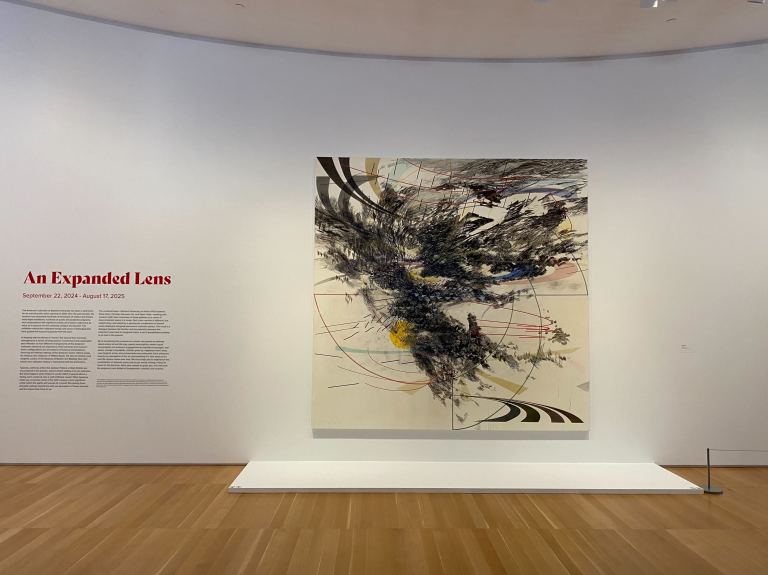Walking upstairs to the Anderson Collection’s newly re-hung second floor galleries, you’re greeted by a dizzying vortex of blacks, reds, yellows and blues. It’s an imposing square canvas, three-meter long on each side.
“Ariel, by Julie Mehretu (born 1970), 2006, ink and acrylic,” its wall label reads. As the poster child of the Anderson’s new installation “An Expanded Lens,” it enjoys an entire wall to itself.
The painting is visually overwhelming — and certainly disorienting at first sight. From afar, it purports to show a bird taking flight; up close, (as close as the guards will allow), it becomes a map of intersecting curves, luminous colors and overlapping circular and triangular forms.
Dominating the picture is a rising mass of black, a sort of vertiginous spiral not unlike a tornado or a cyclone. It’s responsible for much of my disorientation. I see it as a storm of birds, circling in the sky before descending on what appears to be a road at bottom right. Or, are they insects, conspiring some vicious attack in a dense, angry swarm? They could also be bats, or dust or drones — or stand-ins for some combination of all the above. It’s this intentional ambiguity that rests at the core of abstract art, offering a limitless freedom of interpretation.
Beyond the central whirlwind of motion, I’m immediately drawn to the four red curves that sweep by on the right. Reflexively, my eyes follow these red and black lines as they snake all across the space, calligraphic and ribbon-like, and guide me through this daunting abstract expanse. Amid the surrounding chaos, they strike me as free and carefree, swimming fluidly alongside clusters of weightier forms.
Equally compelling are the four fan-like shapes that swirl about the center of the composition. (They remind me of honeydew slices, something I now can’t unsee.) What role do these shapes play in the composition as a whole? For me, their edges double as boundaries that divide the square canvas into four equal quadrants, offering some level of symmetric solace amid the surrounding distortion.
But they also pull me deeper into the image, straight into the eye of the storm. Taken meteorologically, they might resemble a hurricane from a bird’s-eye view — “Ariel” and “aerial”? They certainly accentuate the sense of velocity and rotation conveyed by those curvilinear forms whirling all around.
Gradually, it occurs to me that what initially presents as a spontaneous scattering of geometric figures is carefully choreographed. In viewing the picture from oblique angles, different textural accents and distinct paint layers come to light, reflecting a mindful, intentional artistic process. Taken together, Mehretu’s curves and shapes almost compose a map of controlled chaos. I find it so instructive, comforting, even, that behind “Ariel’s” frenetic whirlwind of activity lies a deliberate, hidden structural clarity.
In this sense, it’s not hard to see why works by this artist are often deemed “story maps.” Julie Mehretu’s connections to cartography run deep: her father was an economic geographer and she holds a longstanding interest in psychogeography — the exploration of memories and emotions as being inextricably tied to place. (Might this identify “Ariel’s” lines and shapes as a map of experiences, of movements across emotional topographies and psychological landscapes?)
I’m also inclined, as many others are, to see Mehretu’s paintings as abstractions of our hectic contemporary experience. The overwhelming, dizzying, intersecting forms, then, would represent the energy and complexity of our 21st-century existence. The limitless complexity of global infrastructure, the red tape of modern bureaucracy, the relentless hustle of urban life — looking back at “Ariel,” it really is all there, spinning in and around Mehretu’s cyclone. Also infused into the picture are the pace of our own trajectories, our careerism and idealism, our endless wants, our fear of stagnation. And the sheer volume of information absorbed, conveyed and transformed through our social networks — that’s there, too.
There’s a key difference, though, between the world I see in “Ariel” and the world we all experience in the flesh: “Ariel’s” world gives me permission to slow down. The disorientation or dislocation I feel at first sight pushes me to observe more intentionally and to question why certain elements (lines, curves, whirlwinds, anxieties) are there. I’m allowed time to understand its abstraction, to discover its curvilinear inhabitants and explore its psychogeographical landscape.
More generally, “Ariel” allows its audience the space to recognize uncomfortable thoughts, generate unexpected ideas and restore internal balance. It allows us the freedom to interpret its meaning, to find our own clarity in Mehretu’s atlas of apparent disorder. In this way, artworks are generous things.
In exiting “Ariel’s” world and returning to our own, I awaken to complete silence in the Anderson Collection’s second-floor galleries. Stepping back, the painting’s forms and curves blend once again into a vortex of blacks, reds, yellows and blues. But I walk away with the knowledge that beneath “Ariel’s” story-map of chaos, there’s actually a subtle geometric order, a careful compositional clarity.
“An Expanded Lens” is on view at the Anderson Collection until Aug. 17, 2025.
